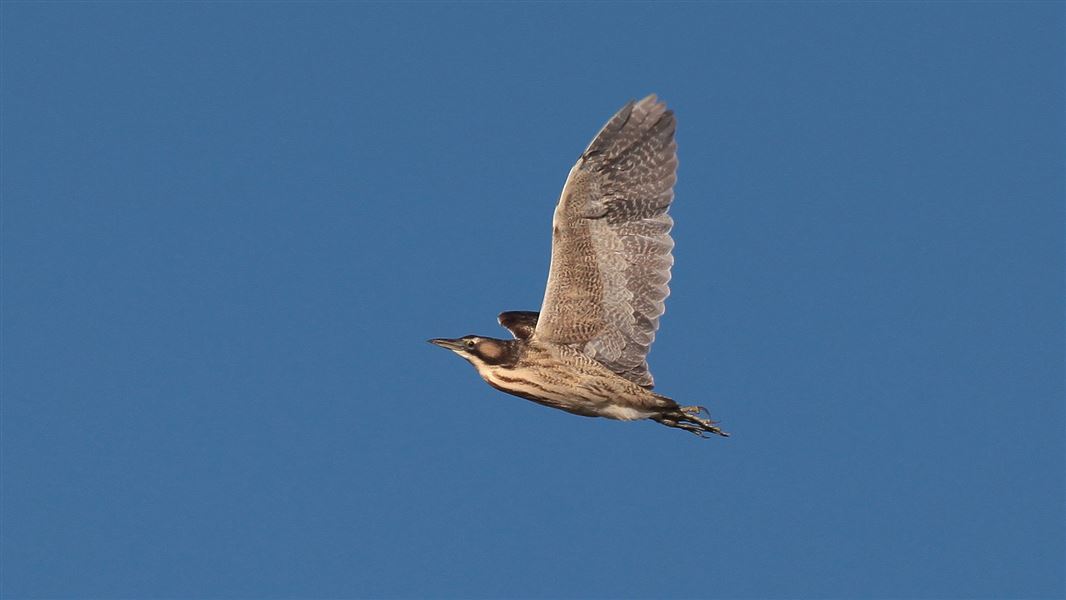Archived content: This media release was accurate on the date of publication.
Date: 02 February 2022
The Australasian bittern/matuku-hūrepo is a rare bird sometimes heard but rarely seen in wetlands across the country. Bittern were common in New Zealand in pre-colonial times but are now classified as “Threatened – Nationally Critical”, numbering less than 1000. Introduced predators, native Australasian Harriers (kāhu), and reduction in wetland habitats and water quality are the main threats to the birds.
The males of the species are known for an unusual booming call to attract females. Listening for this distinctive sound helps estimate the birds’ population within their preferred habitats, using audio recording devices or trained volunteers scattered around wetlands.
But those methods mean current bittern population estimates are based on male numbers only. The use of a drone fitted with a thermal imaging camera will give new insight into the species, allowing scientists to monitor female bittern and nesting success.
Harry Caley, DOC’s Wetland Birds Science Advisor, says the drone trial flights were carried out at five sites around Bay of Plenty and Coromandel: Little Waihi Estuary, Kaituna Wetland, Waimapu Estuary, Pahoia Estuary and Whangapoua Harbour.
Researchers and volunteers, led by DOC’s Tauranga-based Biodiversity Ranger Karl McCarthy, spent many hours locating male bittern to determine where their territories were. Then ecologists at Flightworks helped find females and their nests using a thermal imaging drone.
The flights coincided with bitterns’ peak breeding season activity. Each flight lasted about 20 minutes, covering 10 to 15 hectares. Across the 49 flights, researchers spotted at least 11 bittern and two nests. The presence of the drone did not disturb the bittern and so a variety of behaviour was also captured on video, including birds mating (thought to be the first time that this has been filmed),
“Thermal imagery works best with a high temperature contrast between bittern and their environment” says Hamish Kendal of Flightworks. “Field work began at 05:30AM each day to take advantage of the cool vegetation contrasting against the warm body temperatures of the bird,” he says.
When nests were found, researchers would walk in on foot to position small camera systems which captured bittern activity that will be crucial to help determine why the bittern population is still falling. The drone also captured the amount of time females leave the nest, development and fledging of chicks, and their predation by other species.
The thermal drone trial was successful in relatively short vegetation of rushes, but has yet to be proven effective at finding the birds and their nests in thicker vegetation like tall raupō.
Nigel Binks, DOC Senior Ranger Biodiversity, says the successful trial of the thermal drone is an important development in the work to protect bittern.
“Detecting female matuku/bittern has historically been quite difficult; the only way to do it is with a trained detection dog walking through a wetland, which is really invasive and can scare females off the nest,” says Nigel Binks. “Being able to identify female bittern will give a more accurate representation of the population,and teach us about the habitat requirements of these birds.
“We plan to use the drone to fly over known nesting habitat types to determine whether we have nesting bittern in Whangamarino, which is one of New Zealand’s internationally recognised Ramsar wetlands. Finding their nests will help determine the main predators of bittern eggs and chicks, and the camera systems will help us do that.
“With this information, we will be better equipped than ever to plan appropriate management to increase the likelihood of successful fledging and, at the same time, add to the population gene pool.”
The thermal drone work was carried out as part of Arawai Kākāriki, DOC’s national wetland restoration programme. The announcement of the successful trial coincides with World Wetland Day, which aims to strengthen and multiply action for protection and enhancement of wetlands.
Contact
For media enquiries contact:
Email: media@doc.govt.nz
